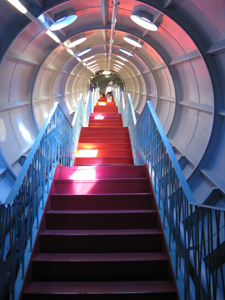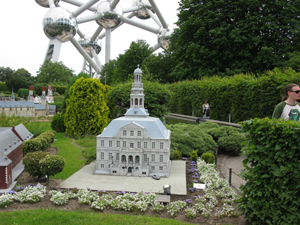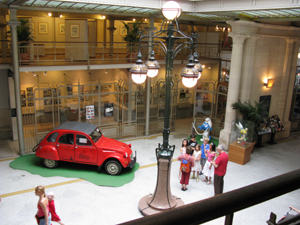Brussels takes its position as a leader of European government very seriously. While we were there, EU  Monogrammed gates
national leaders met to discuss the Irish vote against the Lisbon treaty. On one early walk, we came upon a street corner awash in policemen who were apparently monitoring the departure of one delegate from his hotel; he was whisked into his limo while alert officers studied the pedestrians nearby.
Monogrammed gates
national leaders met to discuss the Irish vote against the Lisbon treaty. On one early walk, we came upon a street corner awash in policemen who were apparently monitoring the departure of one delegate from his hotel; he was whisked into his limo while alert officers studied the pedestrians nearby.
We decided to get a little more adventurous with Brussels public transportation. We took the Metro 1A to station Stuyvenbergh and then walked through the royal domain "van Laken" to see the large castle and the impressive Gothic mausoleum. Apparently the royal family was not in residence, because the guardhouses were unmanned and the gates closed. We then picked our way northwest through a pretty park  Stairs in the Atomium
to the Atomium.
Stairs in the Atomium
to the Atomium.
The Atomium in Brussels is a giant stainless steel model of an iron atom. The star of the 1958 Brussels World's Fair, it shines through its surrounding trees, visible far and wide. A visit to the Atomium begins with an elevator ride up to the middle dome, followed by an escalator to an upper level. From this ball, we looked out over Brussels, and down to Mini-Europe just below. Photos and souvenirs from Expo 58, including visits of the king and queen, were displayed to the special delight of the Belgian  Mini-Europe and Atomium
visitors. In fact, throughout Brussels there were various celebrations of the 50th anniversary of this, the first World's Fair after the Second World War. We photographed our surroundings, climbed the staircases through the Atomium, declined the opportunity for the special experience of a building built out of plastic beer crates, and proceeded to Mini-Europe.
Mini-Europe and Atomium
visitors. In fact, throughout Brussels there were various celebrations of the 50th anniversary of this, the first World's Fair after the Second World War. We photographed our surroundings, climbed the staircases through the Atomium, declined the opportunity for the special experience of a building built out of plastic beer crates, and proceeded to Mini-Europe.
Mini-Europe was also a star of Expo 58, and is still a pleasant exploration, as it has been slowly
expanded over the years. A snaking path leads past dozens of 1/25 scale models of famous landmarks from  Bridge at Ljubljana
European countries. Boats and trains move through the models. We enjoyed identifying the more famous buildings -- the Eiffel Tower, Westminster Abbey, the Acropolis, and so on. Josef Plecnik's famous bridge -- in 1929 he added pedestrian bridges to the central stone bridge to improve traffic flow -- was the symbol for Ljubljana, Slovenia. Mount Vesuvius rumbled and shook, the leaning tower leaned, and the whole park was surrounded by dozens of restaurants, souvenir shops and a movie theater.
Bridge at Ljubljana
European countries. Boats and trains move through the models. We enjoyed identifying the more famous buildings -- the Eiffel Tower, Westminster Abbey, the Acropolis, and so on. Josef Plecnik's famous bridge -- in 1929 he added pedestrian bridges to the central stone bridge to improve traffic flow -- was the symbol for Ljubljana, Slovenia. Mount Vesuvius rumbled and shook, the leaning tower leaned, and the whole park was surrounded by dozens of restaurants, souvenir shops and a movie theater.
It was at Mini-Europe that we enjoyed steamed mussels, Brussels mussels, generally called "moules" in French. Emily, already a seafood fancier, enjoyed sampling them. Unfortunately, we only found them at one other  Comic Strip Museum
restaurant this trip.
Comic Strip Museum
restaurant this trip.
For many tourists, this would have been a full day, but we finished our afternoon with a stop at Le Centre Belge de la Bande Dessinee (the comic strip museum). TinTin, by Herge, is, of course, the best-known of Belgian comics. We hadn't realized that the Smurfs are also Belgian, and very popular there. We enjoyed browsing the rows upon rows of comic strips of all kinds, from goofy humor to exciting chase-and-adventure stories. The museum is housed in a 1906 department store designed by the famous Belgian architect and furniture maker, Victor Horta, whose flowing vines and romantic decorations represent art nouveau at its peak. We could have spent more hours looking at the exhibits, but our legs protested "we need rest!"
 Monogrammed gates
national leaders met to discuss the Irish vote against the Lisbon treaty. On one early walk, we came upon a street corner awash in policemen who were apparently monitoring the departure of one delegate from his hotel; he was whisked into his limo while alert officers studied the pedestrians nearby.
Monogrammed gates
national leaders met to discuss the Irish vote against the Lisbon treaty. On one early walk, we came upon a street corner awash in policemen who were apparently monitoring the departure of one delegate from his hotel; he was whisked into his limo while alert officers studied the pedestrians nearby.
 Stairs in the Atomium
Stairs in the Atomium Mini-Europe and Atomium
Mini-Europe and Atomium Bridge at Ljubljana
Bridge at Ljubljana Comic Strip Museum
Comic Strip Museum